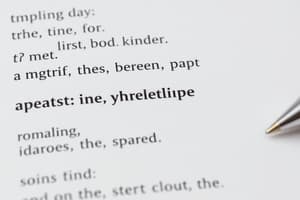Podcast
Questions and Answers
Match the following Japanese words with their English meanings:
Match the following Japanese words with their English meanings:
gakusei = student senseiga = teacher tegamio = letter ni = to
Match the following Japanese word order with its description:
Match the following Japanese word order with its description:
SOV = Subject-Object-Verb SVO = Subject-Verb-Object OSV = Object-Subject-Verb VSO = Verb-Subject-Object
Match the types of nouns with their definitions:
Match the types of nouns with their definitions:
Common noun = Something you can see or touch Proper noun = The name of a specific person or place Mass noun = Cannot be counted individually Collective noun = Names a group of individuals
Match the following content word classes with examples:
Match the following content word classes with examples:
Match the following word classes to their characteristics:
Match the following word classes to their characteristics:
Match the following examples with their noun types:
Match the following examples with their noun types:
Match the following English terms with their Japanese equivalents:
Match the following English terms with their Japanese equivalents:
Match the following elements of sentence structure:
Match the following elements of sentence structure:
Match the Japanese sentence parts with their English roles:
Match the Japanese sentence parts with their English roles:
Match the examples with their corresponding grammatical terms:
Match the examples with their corresponding grammatical terms:
Match the language with its corresponding prepositional phrase:
Match the language with its corresponding prepositional phrase:
Match the type of adverb with its function:
Match the type of adverb with its function:
Match the verbs to their appropriate usage type:
Match the verbs to their appropriate usage type:
Match the conjunction with the provided example:
Match the conjunction with the provided example:
Match the adverbial phrase with its language:
Match the adverbial phrase with its language:
Match the structure to its description:
Match the structure to its description:
Match the languages with their examples of indirect objects:
Match the languages with their examples of indirect objects:
Match the type of adpositions to their definitions:
Match the type of adpositions to their definitions:
Match the following terms with their definitions:
Match the following terms with their definitions:
Match the following components of the Innateness Hypothesis:
Match the following components of the Innateness Hypothesis:
Match the following theories with their descriptions:
Match the following theories with their descriptions:
Match the following principles of UG with their meanings:
Match the following principles of UG with their meanings:
Match the following aspects of UG with their characteristics:
Match the following aspects of UG with their characteristics:
Match the following types of language theories with their characteristics:
Match the following types of language theories with their characteristics:
Match the following hypotheses with their implications:
Match the following hypotheses with their implications:
Match the following elements of language with their functions:
Match the following elements of language with their functions:
Match the following statements regarding language acquisition with their traits:
Match the following statements regarding language acquisition with their traits:
Match the following types of articles with their descriptions:
Match the following types of articles with their descriptions:
Match the following demonstrative pronouns with their examples:
Match the following demonstrative pronouns with their examples:
Match the following quantifiers with their definitions:
Match the following quantifiers with their definitions:
Match the following types of pronouns with their descriptions:
Match the following types of pronouns with their descriptions:
Match the following conjunctions with their types:
Match the following conjunctions with their types:
Match the following sentences with the correct pronoun type:
Match the following sentences with the correct pronoun type:
Match the following pronoun examples with their functions:
Match the following pronoun examples with their functions:
Match the following sentences with their correct interrogative forms:
Match the following sentences with their correct interrogative forms:
Match the following quantifiers with their uses:
Match the following quantifiers with their uses:
Match the following phrases with their descriptions:
Match the following phrases with their descriptions:
Match the following word classes with their examples:
Match the following word classes with their examples:
Match the following constituency tests with their descriptions:
Match the following constituency tests with their descriptions:
Match the following phrase structure rules with their corresponding phrases:
Match the following phrase structure rules with their corresponding phrases:
Match the following syntactic units with their examples:
Match the following syntactic units with their examples:
Match the following phrases with their types:
Match the following phrases with their types:
Flashcards are hidden until you start studying
Study Notes
Introduction to Syntax
- Syntax is the study of sentence structure
- Syntax is the part of grammar that deals with the arrangement of words in sentences.
Lectures
- Lecture 9 focuses on principles and parameters of languages, specifically those related to the Innateness Hypothesis.
Innateness Hypothesis
- The Innateness Hypothesis states that certain aspects of language are "known" without prior language experience.
- These innate aspects are biologically available, present at birth, not acquired, part of genetic inheritance, and universal.
- UG Principles are genetically determined principles that guide children in acquiring a first language.
Universal Grammar (UG)
- UG contains a set of principles that are universal across all languages.
- However, UG does not imply that all languages are grammatically identical.
- Languages have parameters, which are variations within universal principles that account for language differences.
Word Classes
- Content words are words that carry descriptive meaning.
- Content words include nouns, verbs, adjectives, adverbs, and prepositions.
- Nouns, verbs, and adjectives are found in all human languages.
- Prepositions are words that express spatial or temporal relationships.
- Examples of prepositions: on, under, in, beside.
Nouns
- Nouns represent people, places, things, and abstract concepts.
- Common nouns are general terms for objects.
- Proper nouns refer to specific people, places, or things.
- Mass nouns refer to substances or things that cannot be counted individually.
Verbs
- Verbs express actions, states, or events.
- Transitive verbs require a direct object.
- Intransitive verbs do not require a direct object.
- Ditransitive verbs require both a direct and an indirect object.
Phrase Structure
- Words combine to form phrases, which are syntactic units.
- Constituents are groups of words that function as a single unit in a sentence.
- Constituency tests are used to determine whether a group of words forms a constituent.
- Substitution tests involve replacing a constituent with another element.
- Coordination tests involve joining two constituents with conjunctions (and, but, or).
Determiners
- Determiners are words that precede nouns, modifying their meaning.
- They specify quantity, definiteness, or proximity.
- Examples of determiners: the, a, an, this, these, that, those.
Pronouns
- Pronouns are functional words that replace nouns.
- Different types of pronouns include personal, possessive, relative, demonstrative, and interrogative.
- Personal pronouns express person and number.
- Examples of personal pronouns: I, you, he, she, it, we, they.
Conjunctions
- Conjunctions link words, phrases, or clauses.
- Coordinating conjunctions (and, or, but) join similar grammatical units.
Postpositions
- Postpositions are similar to prepositions, but they follow the noun phrase they modify.
- Examples of postpositions: in, on, with, from, to.
Studying That Suits You
Use AI to generate personalized quizzes and flashcards to suit your learning preferences.




